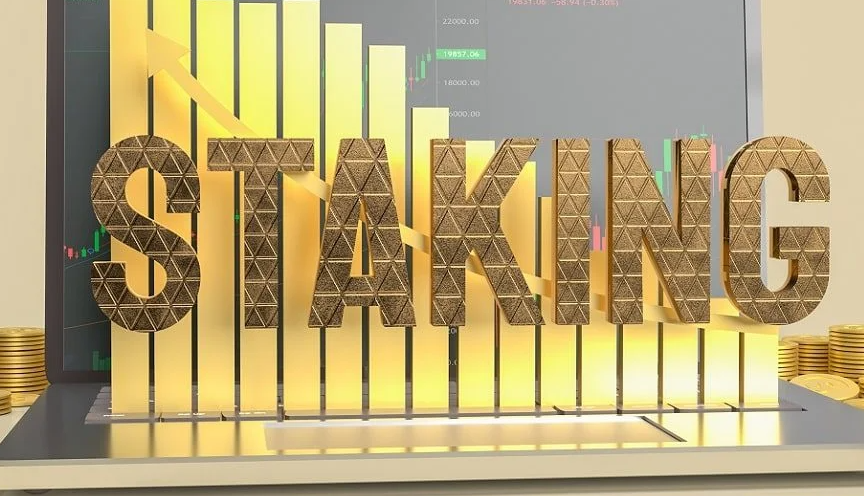In some ways, staking is similar to depositing cash in a high-yield savings account. Banks lend out your deposits, and you earn interest on your account balance.
In theory, staking isn’t too different from the bank deposit model, but the analogy only goes so far. Here’s what you need to know about crypto staking.
What Is Staking?
Staking is when you lock crypto assets for a set period of time to help support the operation of a blockchain. In return for staking your crypto, you earn more cryptocurrency.
Many blockchains use a proof of stake consensus mechanism. Under this system, network participants who want to support the blockchain by validating new transactions and adding new blocks must “stake” set sums of cryptocurrency.
Staking helps ensure that only legitimate data and transactions are added to a blockchain. Participants trying to earn a chance to validate new transactions offer to lock up sums of cryptocurrency in staking as a form of insurance.
If they improperly validate flawed or fraudulent data, they may lose some or all of their stake as a penalty. But if they validate correct, legitimate transactions and data, they earn more crypto as a reward.
Popular cryptocurrencies Solana (SOL) and Ethereum (ETH) use staking as part of their consensus mechanisms.
How Does Staking Work?
If you own a cryptocurrency that uses a proof of stake blockchain, you are eligible to stake your tokens. Staking locks up your assets to participate and help maintain the security of that network’s blockchain. In exchange for locking up your assets and participating in the network validation, validators receive rewards in that cryptocurrency known as staking rewards.
You can also set up a cryptocurrency wallet that supports staking.
How To Make Money Staking Crypto?
When you choose a program, it will tell you what it offers for staking rewards. As of December 2022, the crypto exchange CoinDCX offers a 5%-20% annual percentage yield (APY) for Ethereum 2.0 staking.
User must stake at least 0.1 ETH in the pool to get started
Once you’ve committed to staking crypto, you will receive the promised return according to the schedule. The program will pay you the return in the staked cryptocurrency, which you can then hold as an investment, put up for staking, or trade for cash and other cryptocurrencies.
What Are The Benefits of Staking Crypto
· Earn passive income. If you don’t plan on selling your cryptocurrency tokens in the immediate future, staking lets you earn passive income. Without staking, you would not have generated this income from your cryptocurrency investment.
· Easy to get started. You can get started staking quickly with an exchange or crypto wallet.
· Support crypto projects you like. “Staking has the added benefit of contributing to the security and efficiency of the blockchain projects you support. By staking some of your funds, you make the blockchain more resistant to attacks and strengthen its ability to process transactions,” says Tanim Rasul, chief operating officer and co-founder of National Digital Asset Exchange, a cryptocurrency trading platform in Canada.
What Are the Risks of Staking Crypto?
When you stake your tokens, you may have to commit them for weeks or months depending on the program. During this time, you wouldn’t be able to cash out or trade your tokens.
Still, since you’re selling on a secondary market, you need to find a willing buyer or lender. Plus, there’s no guarantee you’ll be able to do so or get all your money back early.
Cryptocurrencies are also extremely volatile investments, where double-digit price swings are common during market crashes. If you’re staking your cryptocurrency in a program that locks you in, you wouldn’t be able to sell during a downturn. The staking platform you choose could offer lucrative annual returns, but if the price of your staked token falls, you could still incur losses.
Many proof of stake networks use “slashing” to punish validators who take improper actions, destroying some of the stake they put up on the network. If you stake with a dishonest validator, you could lose part of your investment for this reason.
Source Forbes.com
Buying CAB coin on the El Capitalo platform has some similarities with staking. You buy a coin and set the time limit for the buyback yourself. By staking, you also lock up crypto assets for a certain period of time to support the operation of the blockchain. Part of El Capitalo's income from trading on crypto exchanges goes to a stabilization fund, which supports the platform in case of seasonal and unexpected fluctuations and the El Capitalo platform itself. Using the blockchain system, each user can observe everything happening in the El Capitalo platform - it gives openness and transparency to the system and El Capitalo participants while remaining confidential. However, one of the benefits of El Capitalo from staking is the amount of income you receive: the growth in the value of the coin is 1% per week, 4% per month and 66% per year.
Please note. It is not a financial recommendation. When applying the information received, remember the need for your own research and analysis of any service or cryptocurrency.
